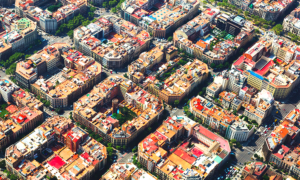Climate and Ecosystem
Barcelona is situated on a plain spanning 17.000 hectare and is bordered by the mountain range of Collserola – highest point (512 SML) – by the Llobregat river in the southwest and the Besòs river in the north.
The city has a Mediterranean climate (Köppen climate classification) characterised by with mild, relatively wet winters and hot, relatively dry summers. Barcelona has an annual average temperature of 17,7 ºC, whereby large fluctuations are rare, especially in the summer months. On average, the city has 55 days of precipitation – occurring predominantly in spring and autumn and totalling around 600 mm -, 38 tropical nights and no ice or frost days yearly.
According to a 2009 regional assessment, commissioned by the Generalitat to the Center for Ecological Research and Forestry Applications (CREAF), Catalonia is composed by 64% of wild land – including forests, other types of vegetation and beaches -, 29% of agricultural land, 6,2% of urban/artificial land and 0,6% of continental waters – including water bodies and wetlands. The study reveals an overall shrinking in agricultural land surface by over 15% since 1993, whereas the most significant increase was registered in urban artificial land, which expanded by 48% over the same period.Between 1956 and 2009, Barcelona increased it pervious surface by 2.800 ha, namely from 45% to 72% over the total municipal area.
Urban Area
Within this geographic context, Barcelona features as the most populous municipality of Catalonia (1.6 million – 2017) and the second largest city in Spain. Its urban footprint stretches for 33.072 hectares and constitutes the largest urban conglomerate in its metropolitan region. To this last extent, Barcelona Metropolitan Area (AMB) includes 36 municipalities, is home to 3.2 million people and exhibits a land use rate of 48% – against a 52% of vacant land. The latter totals 40.124 hectares – 17,5% of which are still developable – and is mainly composed by made of woodland, beaches and non-occupied land.
In terms of urban development, Barcelona’s physical expansion has been constrained both by the mountains and by the sea; resulting in a relatively high population density – among the highest in Europe (15.992 people per Km2).Barcelona commenced the 20th century with a population of over 533.000 which increased slowly but steadily until the 1950’s, when the city started absorbing a high number of residents from other less-industrialized areas of Spain. According to a regional survey carried out by the Housing Consortium, 437.631 housing units were owned outright and 205.912 are rented, as of 2011, while a remaining 6% of the housing stock was given for free/at a lower price, or through other tenure arrangements.


